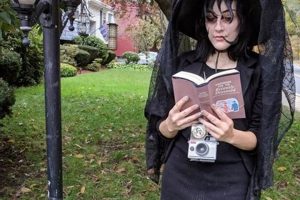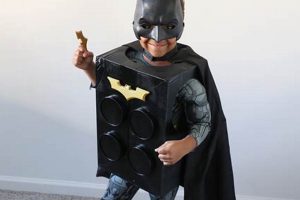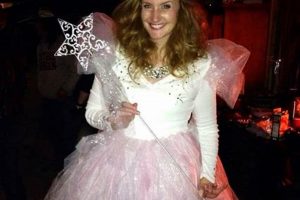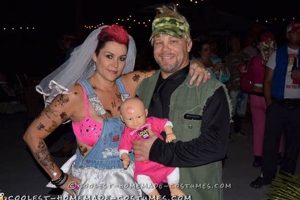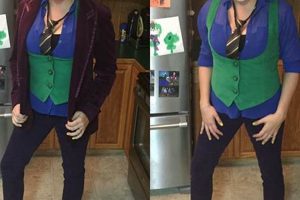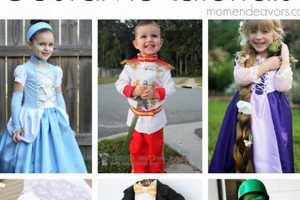Creating a homemade outfit inspired by the character Minerva McGonagall involves designing and assembling various elements to replicate her distinctive appearance. This typically includes a long, dark green or black robe, a pointed hat, and potentially a tartan scarf or shawl, all chosen and constructed by the individual.
The practice of crafting such an attire offers several advantages. It allows for personalized expression and creativity, resulting in a unique representation of the character. Furthermore, it often provides a more cost-effective alternative to purchasing commercially manufactured costumes. Historically, individuals have created their own garments and costumes for various purposes, reflecting resourcefulness and artistic skill.
The subsequent sections will explore the key components required for successful assembly, detailing the materials, construction techniques, and accessory options to consider when replicating the iconic look of this character.
Essential Assembly Guidance
The following recommendations offer practical advice for achieving an accurate and visually appealing representation of the character’s attire.
Tip 1: Fabric Selection: Opt for heavyweight fabrics such as wool blends or gabardine for the robe, ensuring a drape that reflects the character’s authoritative presence. Consider velvet or a similar textured material for the hat to add a touch of elegance.
Tip 2: Robe Construction: Prioritize a pattern that incorporates a full, flowing design with wide sleeves. Ensure accurate measurements are taken to achieve a proper fit, allowing for ease of movement while maintaining a dignified silhouette.
Tip 3: Hat Shape and Structure: The pointed hat should maintain a defined shape. Use stiff interfacing or buckram to provide structural support, preventing the hat from collapsing or losing its form. Aim for a height that is proportionate to the overall costume, typically around 14-16 inches.
Tip 4: Tartan Scarf or Shawl: Select a tartan pattern that is either screen-accurate to the films or approximates a traditional Scottish design. Authenticity in the pattern enhances the overall impression of the outfit.
Tip 5: Accessory Detailing: Consider adding subtle details such as antique-style brooches or spectacles to enhance the overall authenticity. Researching specific accessories used by the character in the source material is recommended.
Tip 6: Mastering the Hair and Makeup: While technically not part of the costume construction, the character’s severe hairstyle and makeup are essential. Aim for a tightly pulled-back hairstyle and a minimalist makeup approach to capture the essence of her persona.
Adhering to these recommendations will improve the overall quality and authenticity of the final product, resulting in a more convincing depiction of the character.
The concluding section will summarize the key aspects of successfully creating this outfit, reaffirming the blend of creativity and precision required.
1. Robe Fabric Weight
The weight of the fabric chosen for the robe is a critical factor in the successful execution of a Minerva McGonagall costume. A lighter fabric results in a robe that lacks the appropriate drape and structure, thus failing to convey the character’s authority and presence. Heavier fabrics, conversely, contribute to a more substantial and authentic appearance, mirroring the character’s established image in the source material. The specific connection between fabric weight and the overall impression stems from the visual language of costuming, wherein heavier materials are often associated with power, wisdom, and formality. For example, consider the difference between a robe constructed from lightweight cotton versus one made from wool gabardine. The latter will naturally hold its shape and convey a more regal bearing.
A robe crafted from a substantial fabric such as melton wool or a heavy twill will not only hang correctly but also provide a more accurate silhouette. This consideration is especially pertinent in recreating the flowing sleeves and full body of the garment, both crucial elements of the costume. Moreover, the durability of the fabric is enhanced with increased weight, ensuring the costume can withstand multiple uses without losing its form or integrity. Think of stage productions or fan conventions where the costume is subjected to extended wear and movement; a robust fabric weight prevents premature wear and tear, maintaining the desired aesthetic.
In conclusion, the selection of an appropriately weighted fabric is fundamental to the authenticity of a Minerva McGonagall costume. It directly influences the robe’s drape, structure, and overall appearance, thereby impacting the success of the costume’s portrayal. While lighter fabrics may offer cost savings or ease of construction, they ultimately compromise the fidelity to the original character design. Prioritizing a heavier fabric weight is a crucial investment in the overall quality and impact of the costume.
2. Hat Structural Integrity
The structural integrity of the hat is paramount in achieving a convincing representation of the character Minerva McGonagall. A poorly structured hat detracts significantly from the overall appearance, undermining the costume’s authenticity. It is therefore necessary to examine the specific factors that contribute to a hat’s form and stability.
- Interfacing Material and Application
The type of interfacing used directly affects the hat’s rigidity and shape retention. Stiff interfacing materials, such as buckram or heavy-weight fusible interfacing, provide the necessary support to maintain the conical form. The method of application, whether sewn-in or fused, is also crucial. Inadequate application can lead to uneven support and distortion of the hat’s shape. A poorly interfaced hat droops, losing the iconic pointed silhouette associated with the character.
- Seam Construction Techniques
The manner in which the hat’s seams are constructed significantly impacts its structural strength. Reinforced seams, achieved through methods such as topstitching or using seam tape, prevent the hat from collapsing or deforming under its own weight or external pressure. Weak seams, on the other hand, result in a hat that is prone to buckling and losing its intended shape. Precisely executed seams ensure the hat maintains its conical form and resists distortion.
- Material Thickness and Composition
The thickness and composition of the outer material contribute directly to the hat’s ability to maintain its shape. Thicker fabrics, such as velvet or felt, inherently offer greater structural stability compared to thinner, more pliable materials. Furthermore, the composition of the fabric influences its rigidity and re
sistance to creasing or folding. A hat constructed from a thin, unstructured fabric requires significantly more internal support to achieve the desired shape, whereas a thicker, more robust fabric provides a more inherently stable base. - Internal Support Systems
In addition to interfacing, internal support systems can further enhance the hat’s structural integrity. Elements such as wire framing or padded bands can be incorporated to reinforce specific areas, such as the brim or the pointed tip. These systems provide additional resistance to deformation and ensure the hat maintains its shape even under stress. The careful integration of these systems, however, is crucial to avoid creating visible distortions or compromising the hat’s overall aesthetic.
The interplay of interfacing, seam construction, material selection, and internal supports directly determines the hat’s capacity to uphold its intended form. Neglecting any of these factors diminishes the hat’s structural integrity, consequently impacting the overall accuracy of a self-made Minerva McGonagall costume. The hat’s stability is not merely an aesthetic concern; it is a fundamental element in conveying the character’s authority and distinctive silhouette.
3. Tartan Pattern Accuracy
In the context of a homemade Minerva McGonagall costume, the accuracy of the tartan pattern significantly influences the overall authenticity and recognizability. The tartan is a distinctive element of the character’s attire, and deviations from established patterns can detract from the costume’s fidelity to the source material.
- Historical Context and Clan Affiliations
Tartans are historically associated with specific Scottish clans and regions, each possessing a unique pattern and color combination. While the specific tartan worn by Minerva McGonagall in the films is not definitively linked to a particular clan, approximating a traditional Scottish tartan adds a layer of authenticity. Selecting a historically plausible pattern, rather than a purely decorative one, elevates the costume’s perceived accuracy. For example, a “Royal Stewart” tartan, although common, might be less fitting than a less ubiquitous, more subdued pattern. The implication here is that attention to historical detail enriches the costume.
- Color Palette and Weave Structure
The colors and weave structure of the chosen tartan directly affect its visual resemblance to the character’s attire. The correct color palette, consisting of specific shades of green, blue, red, and yellow, is crucial. Similarly, the weave structure, defining the pattern’s geometry and density, should closely match the source material. If the weave structure is significantly different, even with similar colors, the tartan will appear dissimilar. For example, a tartan with a dense, tight weave will present a different visual texture compared to one with a looser, more open weave, thereby affecting the overall impression of the costume.
- Scale and Proportion of the Pattern
The scale and proportion of the tartan pattern influence its visual impact. A tartan with a large-scale pattern may appear overwhelming or cartoonish, while a tartan with a very small-scale pattern may lack definition and visual interest. The ideal scale is one that is proportional to the size of the scarf or shawl and complements the overall costume. A balanced proportion contributes to a more harmonious and believable representation of the character. If the scale is noticeably off, the costume may appear either too busy or too plain.
- Fabric Composition and Drape
The fabric composition influences how the tartan pattern drapes and displays. A wool or wool-blend fabric typically drapes more effectively and authentically than a synthetic material such as polyester. The fabric’s drape affects the pattern’s appearance, particularly when the scarf or shawl is worn. A fabric that drapes poorly can distort the pattern and detract from its overall impact. Therefore, selecting a fabric that complements the chosen tartan pattern is essential for achieving a visually accurate and pleasing result. A heavier wool, for example, will display the pattern differently than a lightweight acrylic.
These aspects of tartan pattern accuracy collectively determine the success of incorporating this element into a self-made Minerva McGonagall costume. Attention to historical context, color palette, weave structure, pattern scale, and fabric drape ensures a more authentic and visually compelling outcome, enhancing the overall recognizability and impact of the costume.
4. Accessory Authenticity
The level of authenticity in accessories directly impacts the overall effectiveness of a homemade Minerva McGonagall costume. A meticulous approach to accessory selection enhances the costume’s resemblance to the character, while neglecting this aspect diminishes its impact. The cause-and-effect relationship is evident: authentic accessories elevate the costume, whereas inaccurate ones detract from it. The accessories serve as visual cues that contribute to the recognizability and believability of the portrayal. The inherent details contained within specific accessories significantly shape the audience’s impression and perception of the overall costume.
Consider the effect of using genuine antique spectacles versus modern, plastic imitations. The antique spectacles, with their aged metal frames and period-appropriate lenses, imbue the costume with a sense of history and authenticity, mirroring the character’s timeless quality. Conversely, plastic imitations appear incongruous and detract from the desired aesthetic. Similarly, the choice of brooch can either enhance or undermine the costume’s credibility. A meticulously crafted brooch, emulating the style and materials of the character’s era, adds a touch of elegance and refinement. Alternatively, a generic or poorly made brooch can appear out of place and diminish the overall impression. Practical applications include diligent research into period-appropriate accessories and sourcing high-quality replicas when genuine antiques are unavailable.
In summary, achieving a successful portrayal hinges on the cumulative effect of accurately representing minute details. While creating a costume independently, prioritizing accessory correctness reinforces the character’s image and ultimately decides whether the attempt is deemed an accomplishment or a misstep. The pursuit of accessory authenticity, though potentially challenging, represents a crucial investment in the overall quality and impact of the assembled attire, solidifying the connection to the portrayed character.
5. Hair/Makeup Precision
In a homemade Minerva McGonagall costume, the precision of hair and makeup plays a critical role in achieving a convincing and recognizable representation of the character. The accuracy in replicating the character’s distinctive hairstyle and makeup directly influences the audience’s perception of the entire costume. Inadequate attention to these details can undermine the effectiveness of even the most meticulously crafted r
obe and accessories. The hair and makeup serve as crucial visual identifiers, establishing a strong connection to the source material and enhancing the overall believability of the portrayal. An example of this impact is a costume with a flawlessly constructed robe paired with an inaccurate hairstyle; the lack of hair precision immediately diminishes the costume’s impact.
Practical applications of this understanding involve careful research into the character’s specific hair and makeup styles. The hairstyle typically involves a tightly pulled-back bun or severe updo, often gray or silver in color. Achieving this look requires precise styling techniques and potentially the use of wigs or hairpieces. The makeup is generally understated, emphasizing a natural yet severe appearance, often with defined eyebrows and minimal use of color. An effort should be directed to matching these details as closely as possible. Consideration could also be given to the lighting condition, particularly on how it may affect the makeup that will be applied.
In summary, while fabric selection, garment construction, and accessory acquisition contribute significantly to a DIY Minerva McGonagall costume, the precision of hair and makeup serves as a key determinant of its overall success. Overlooking these details can diminish the impact of the entire costume, highlighting the importance of thorough research, accurate styling techniques, and a commitment to replicating the character’s distinctive appearance as faithfully as possible. The challenge lies in achieving a balance between personal interpretation and adherence to established visual cues to create a compelling and recognizable portrayal.
Frequently Asked Questions
This section addresses commonly encountered inquiries regarding the creation of a homemade Minerva McGonagall costume, providing clear and concise answers to aid in successful assembly.
Question 1: What is the recommended fabric weight for the robe to achieve an authentic drape?
A fabric weight of at least 10 ounces per square yard is recommended for the robe. This ensures a substantial drape, accurately reflecting the character’s authoritative presence. Materials such as wool gabardine or heavy twill are suitable choices.
Question 2: How can the pointed hat be constructed to maintain its shape effectively?
The pointed hat necessitates a rigid internal structure. Buckram or heavy-weight interfacing should be utilized to provide support. Sewn-in interfacing generally offers superior long-term stability compared to fusible options.
Question 3: Are there specific tartan patterns that are more appropriate than others for the scarf or shawl?
While the precise tartan worn by the character is not definitively established, approximating a traditional Scottish pattern enhances authenticity. Subdued color palettes and historically plausible designs are preferable to overtly modern or generic tartans.
Question 4: What types of accessories are essential for a convincing Minerva McGonagall costume?
Key accessories include period-appropriate spectacles, an antique-style brooch, and potentially a wand. The spectacles should feature metal frames, and the brooch should reflect a classic, understated design. A wand adds a final detail that is congruent with the nature of the character.
Question 5: How can the hairstyle be replicated accurately without resorting to a professional stylist?
Achieving the hairstyle typically involves tightly pulling back the hair into a severe bun or updo. Wigs or hairpieces may be necessary to replicate the color and volume effectively. Practice and attention to detail are crucial.
Question 6: What makeup techniques are most effective in capturing the character’s distinctive appearance?
The makeup should be understated and emphasize a natural, yet stern, appearance. Defined eyebrows and minimal use of color are characteristic. Avoiding overly elaborate or modern makeup styles is essential for maintaining authenticity.
In summary, successful creation hinges on attention to fabric weight, hat structure, accurate tartan representation, accessory selection, hairstyle replication, and makeup application. Diligence in these areas will lead to a more compelling and recognizable portrayal.
The subsequent section provides concluding remarks, emphasizing key takeaways and reinforcing the importance of careful planning and execution.
Conclusion
This exploration of crafting a diy minerva mcgonagall costume has underscored the intricate considerations necessary for a successful representation. The analysis of fabric weight, hat construction, tartan pattern accuracy, accessory authenticity, and hair/makeup precision reveals the interconnected nature of these elements. A compromised execution in any of these areas diminishes the overall impact, hindering the goal of a convincing portrayal.
The pursuit of a meticulously crafted homemade rendition demands a commitment to detail and a thorough understanding of the character’s established visual characteristics. While creativity and personal interpretation are valuable, fidelity to core attributes remains paramount. Success hinges not only on technical skill but also on a deep appreciation for the source material, ensuring a respectful and recognizable tribute.


